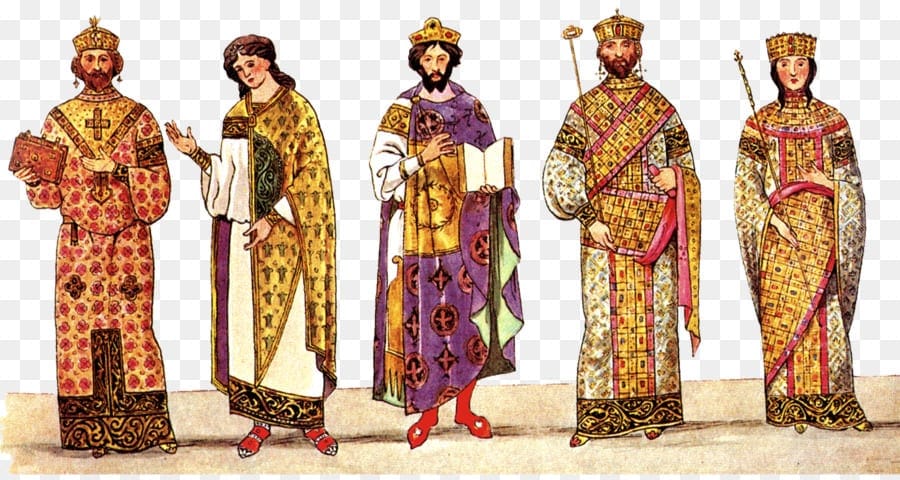Imagine standing before the Byzantine emperor, his presence radiating power and authority. He’s draped in a symphony of colors and fabrics, each element meticulously chosen to convey his divine right to rule. “Decoding the Majesty” unveils the hidden language of these opulent robes, taking you on a journey through the history, symbolism, and grandeur of the Byzantine court. From the exclusive loros to the intricate tablion, discover how these wearable masterpieces reflected the emperor’s authority and shaped the empire’s legacy.
Unraveling the Symbolism: A Closer Look at Imperial Garb
Ever wonder what those elaborate robes meant for a Byzantine Emperor? They were far more than just fashion statements! Let’s delve into the world of Byzantine fashion and decode the meaning woven into every thread.
The Loros: A Sash of Supreme Authority
Picture a luxurious silk band, casually draped over the left shoulder and wrapped around the waist – that’s the loros, the ultimate mark of Byzantine power. Reserved exclusively for the emperor and his close family, the loros was a visual declaration of their authority, akin to a crown. It instantly signaled their status and set them apart within the Byzantine hierarchy.
Purple Reign: The Color of Divine Right
In the Byzantine world, purple wasn’t just a color; it was a statement. This rich hue, especially in its most vibrant shades, was synonymous with imperial power. By wearing purple, the emperor declared, “I am chosen by God,” subtly reminding everyone of his divine right to rule.
Beyond the Purple: A Tapestry of Opulence
Of course, Byzantine emperors didn’t limit themselves to just purple. Their robes were legendary for their sheer extravagance. Shimmering silks, intricately woven with gold embroidery and adorned with a dazzling array of jewels, transformed these garments into wearable masterpieces. These weren’t just clothes; they were a testament to the wealth and artistry of the Byzantine Empire.
Talking Threads: Messages Hidden in Silk and Gold
Every detail on an emperor’s robe was strategically placed. Intricate patterns and designs weren’t mere decoration; they often depicted religious figures like saints or angels or incorporated powerful symbols like crosses or eagles, all strategically chosen to reinforce the emperor’s image as God’s chosen representative on Earth.
A Wardrobe Fit for an Emperor: Garments of Power and Prestige
An emperor’s wardrobe wasn’t limited to a single robe. They had an entire collection of garments, each with its own specific role and symbolism:
| Garment | Description |
|---|---|
| Tunica/Chiton | A long tunic, often made of silk for the emperor, served as the base layer. |
| Dalmatica | This heavier tunic, worn over the chiton, added warmth and style and eventually became a vestment in the Christian church. |
| Chlamys | This flowing cloak, fastened at the shoulder, signified status, especially when adorned with… |
| Tablion | …a lozenge-shaped panel that shouted the wearer’s rank through its color, embroidery, and jewels. |
| Paragauda | A luxurious border of fabric on robes – the more ornate, the higher the rank! |
Fashion as a Mirror of Byzantine Society
Just like in the modern world, fashion in Byzantium was a powerful form of communication. It reflected social structures and hierarchies. The emperor, adorned in his opulent and heavily symbolic attire, stood at the pinnacle of this system, his clothing a constant reminder of his supreme power.
Religion and Symbolism: The Emperor’s Divine Mandate
The Byzantine Empire was deeply religious, and this piety permeated every aspect of life, including fashion. Religious imagery, woven into the very fabric of imperial robes, served to legitimize the emperor’s rule. It reinforced the idea that he wasn’t just a ruler but a divinely appointed leader, tasked with protecting the Christian faith.
East Meets West: A Fusion of Styles in Imperial Attire
Byzantine fashion was a captivating blend of influences. It seamlessly merged the grandeur and tradition of the Roman Empire with the exotic allure and rich textiles of the East. This unique fusion created a style both opulent and deeply symbolic, reflecting the empire’s pivotal position at the crossroads of Europe and Asia.
Dazzling the World: Power Dressing for Foreign Dignitaries
Imagine being a foreign ambassador, granted an audience with the Byzantine emperor. You enter the opulent hall, and your eyes meet his. He stands before you, a vision of power in a robe of the deepest purple, practically radiating authority. The air shimmers with light reflecting off the countless threads of gold and the glittering jewels sewn into his magnificent attire. This carefully orchestrated display of wealth and power was designed to leave a lasting impression – a potent reminder of the Byzantine Empire’s might and majesty.
What Did Byzantine Emperors Wear?
Step into a world of shimmering silks, sparkling jewels, and colors so rich they seem to glow. This was the world of Byzantine emperors, where clothing transcended mere practicality; it was a potent symbol of wealth, authority, and divine right.
Instead of simple shirts and pants, emperors donned luxurious tunics – long, flowing garments, but on a whole other level of extravagance! These weren’t your average hand-me-downs; they were adorned with intricate embroidery, showcasing the unparalleled skill of Byzantine artisans. And as if that wasn’t enough, they’d throw on a chlamys, a type of cape, or for truly grand occasions, a mandyas, an even more elaborate cloak. A fancy clasp called a tablion held it all together, instantly signaling their high rank.
And then, there’s the purple. Not just any purple – we’re talking a deep, rich hue whispered to be fit only for emperors, representing their status as God’s chosen ruler. To further cement their position, they spared no expense, adorning their outfits with dazzling jewels and pearls. Talk about making a statement!
But there’s more to Byzantine fashion than meets the eye. It represented a fascinating blend of cultures – the grandeur of ancient Rome, the vibrant textiles of Persia, and the symbolism of Christianity, all woven together. This unique mix created a style that was both visually stunning and deeply meaningful.
So, the next time you envision a Byzantine emperor, forget ordinary clothes. Imagine luxurious fabrics, shimmering jewels, and that iconic purple – a visual reminder that they weren’t just rulers, but living embodiments of power and divine authority. Their clothing spoke volumes before they even uttered a word.
What we know about Byzantine fashion comes from a variety of sources, including fragmented garments, detailed mosaics, and written descriptions. However, it’s important to remember that our understanding is still evolving as new discoveries are made. There’s still much to uncover about the intricacies of their attire and the meanings they held.
Did Byzantines Wear the Toga?
While the toga is synonymous with ancient Rome, did the Byzantines – the eastern continuers of Roman tradition – embrace this garment as well? The answer, perhaps surprisingly, is not really.
The iconic draped cloth of the Roman Republic and early Empire had evolved into a largely ceremonial outfit by the time the Byzantine Empire flourished. It wasn’t practical for everyday life. Byzantines, instead, embraced the dalmatica, a long, flowing tunic worn by both men and women. This shift away from the toga reflects how the Byzantines, while inheriting Roman legacy, forged their own unique cultural identity, heavily influenced by the East.
That’s not to say the toga disappeared completely. It popped up occasionally, especially in religious ceremonies, much like how traditional clothing is worn for special occasions today. The toga’s legacy lived on in intriguing ways, particularly in some of the elaborate vestments worn by Byzantine priests, such as the pallium, a band of cloth worn around the shoulders.
So, while the average Byzantine citizen wouldn’t be caught dead in a toga, it’s important to remember that fashion is rarely static. It evolves, adapts, and carries echoes of the past in sometimes unexpected ways.
Dive into the fascinating history of the 1873 invention in San Francisco, a pivotal moment that shaped the city’s future.
What Were Byzantine Emperors Called?
The Byzantine Empire, a civilization that thrived for over a millennium, left an indelible mark on art, architecture, and culture. At the heart of this empire were its emperors, figures of immense power and authority. But what titles did they claim, and what do they reveal about the empire’s identity?
These rulers didn’t settle for a single title; they adopted several, each carrying specific weight and meaning:
- Augustus: Inherited from their Roman predecessors, this title linked Byzantine emperors to the legacy of Rome, presenting them as the rightful successors to a glorious past.
- Basileus: This Greek term, meaning “king” or “sovereign,” reflected the empire’s increasingly Greek character and the emperor’s supreme authority.
- Autokrator: Meaning “self-ruler,” this title emphasized the emperor’s absolute power, setting them apart from any external authority, including the by then diminished Western Roman Empire.
To further solidify their legitimacy, Byzantine emperors often incorporated religious elements into their titulature. Phrases like “In Christ” or “Emperor of the Romans” underscored their role as divinely appointed rulers, chosen by God to lead and protect the Christian faithful.
So, when unraveling the complexities of Byzantine history, remember that their emperors bore more than just the weight of their empire; they carried a tapestry of titles, each thread woven together to project an image of power, legitimacy, and divine right.
Why Were Byzantine Emperors Called “Basileus”?
Byzantine emperors initially embraced Roman titles, clinging to the legacy of their predecessors. However, as the empire evolved, so did their choice of titles. “Basileus,” a Greek word meaning “king” or “sovereign,” eventually overshadowed the Latin “Imperator.”
This shift, occurring around the 7th century AD, wasn’t merely cosmetic; it reflected a profound cultural and political transformation within the Byzantine Empire:
- Embracing a Greek Identity: As the Byzantine Empire became increasingly centered on the Greek language and Eastern Orthodox Christianity, “Basileus” resonated more strongly than its Latin counterparts.
- Projecting Absolute Authority: More than just a king, “Basileus” conveyed a sense of divine right and absolute power. It set the emperor apart as God’s chosen ruler.
- Asserting Independence: By adopting “Basileus,” Byzantine emperors signaled their independence from the declining Western Roman Empire, solidifying their position as the true heirs to Roman authority in the East.
The transition to “Basileus” was a power move, a declaration of the Byzantine Empire’s evolving identity and its emperor’s supreme authority. “Basileus” wasn’t just a title; it was a statement, boldly proclaiming, “We are the new Rome, and our power comes from God.”
Explore the dapper style of the roaring ’20s with our ultimate guide to 1920s outfits for guys.









